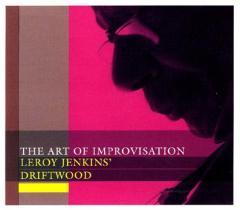LEROY JENKINS' DRIFTWOOD / The Art of Improvisation
Leroy Jenkins (violin); Min Xiao-Fen (pipa); Denman Maroney (piano); Rich O'Donnell (percussion)
"Individually the four players are marvelous; collectively they are something special. This is a beautiful work." - Chris Kelsey, Jazz Times
Jenkins was born in Chicago, Illinois in 1932; he died in Brooklyn, 2007. He was already performing on violin at the age of 8 at his local Baptist Church. He studied music in high school and then attended Florida A&M University where he completed his B.S. in music.
Jenkins returned to Chicago in 1965 and was drawn into the well spring of Chicago's creative music activities. Almost immediately, he joined the Association for the Advancement of Creative Music (AACM). Jenkins recalls that this union marked the first time that as a violin player he was truly welcomed into creative music performances. During this time he played and recorded with Muhal Richard Abrams, Leo Smith and Anthony Braxton.
In 1969, Jenkins left for Paris with Braxton and Smith. With the addition of drummer Steve McCall, they formed the Creative Construction Company. Their 1970 performance in New York, joined by Richard Davis on bass and Abrams on piano, gave New York the first taste of the new music that Chicago musicians were creating. Jenkins continued to work with the finest creative musicians: Archie Shepp, Albert Ayler, Alice Coltrane, Mtume, and Cal Massey, to name a few.
But it was the work of the collective Revolutionary Ensemble (co-founded with bassist Sirone and drummer Jerome Cooper) that gained Jenkins prominence as the most significant violinist of the modern era.
Min Xiao-Fen was a pipa soloist for the famed Nanjing Traditional Music Orchestra of China for more than ten years. She learned the pipa with her father Min Ji-Qian, a professor and pipa master at Nanjing University. Internationally known for her virtuosity and fluid style, she has received high acclaim for her classical, new music, and jazz performances.
Denman Maroney's music is inspired by the sound of crickets and power tools among other things and by the music of John Cage, Ornette Coleman, Henry Cowell, Charles Ives, Olivier Messiaen, Thelonius Monk, Conlon Nancarrow, and Karlheinz Stockhausen among others. Maroney approaches the piano as a stringed as well as percussion instrument. Like any string player (and unlike any piano player), he can produce slow as well as fast attack envelopes, sustain as well as decay envelopes, moving as well as fixed pitches, unequal as well as equal tempered intervals, and manifold timbres.
The multi-facets of Rich O'Donnell span 45 years as virtuoso percussionist, composer, designer and builder of percussion and electronic instruments, teacher and writer. He is director of the Electronic Music Studio at Washington University, head of the Washington University Percussion Department, and music director of New Music Circle. He was 43 years with the St. Louis Symphony Orchestra, most of them as principal percussionist.
TRACK LIST
The Art Of Improvisation:
To Live (10:41)
To Sing (18:00)
To Run (5:02)
To Believe (8:32)
REVIEWS
Bill Shoemaker, Point of Departure
New methods of structuring improvisations are devised daily; but rhythm remains one of the most reliable. It is open-ended, as it does not address pitch or timbre; at the same time, rhythm is a catalyst that assures at least an initial continuity. Violinist Leroy Jenkins uses this approach with brilliant results on the debut of Driftwood, a quartet with pipa player Min Xiao-Fen, pianist Denman Maroney, and percussionist Rich O¹Donnell. The parameters of each of the four movements are set with infinitive verb, a tempo description and a metronome setting i.e.: "To Sing Andante Cantabile (quarter note symbol) = 80." Taking the prompts of each movement to heart especially the intriguing "To Believe Pure Motion (quarter note symbol) = 0" Jenkins and his collaborators almost instantly coalesce as ensemble, while giving each musician enough space on an ongoing basis to truly add to the unfolding music. The ensemble's complementary textures the sustain of Jenkins' bowing, the quick decay of the pipa, the shimmering metallic highlights of Maroney¹s preparations, and the small details of O¹Donnell's percussion also play a large role creating and sustaining the music¹s momentum. Yet, Driftwood's most admirable quality is their restraint. Each of its members are virtuosos (for those not familiar with O¹Donnell, he is the former principal percussionist with the St. Louis Symphony Orchestra), but they never disrupt the collectively articulated equilibrium.
No AACM’er has done the classical-jazz-world music fusion better than Leroy Jenkins. This album presents the violinist at his homespun/highbrow best. Featuring a string-centric lineup of Jenkins, pianist Denman Maroney, pipa player Min Xiao-Fen and percussionist Rich O’Donnell, it was recorded live in 2004 at an AACM concert in New York City.
Tempo markings are given if not explicitly followed; the music is heavily if not totally improvised. Maroney is unusually perceptive when it comes to timbre and admirably restrained when it comes to finding a place in the ensemble. Xiao-Fen is similarly egoless. She functions almost as a guitarist would, adding a percussive melodicism, playing postmodern Reinhardt to Jenkins’ free-jazz Grappelli. O’Donnell’s percussion interacts like a melodic instrument. He too has a keen sense of timbre and a powerful if slightly crooked manner of generating rhythmic intensity.
Jenkins is typically excellent. Individually the four players are marvelous; collectively they are something special. This is a beautiful work.

